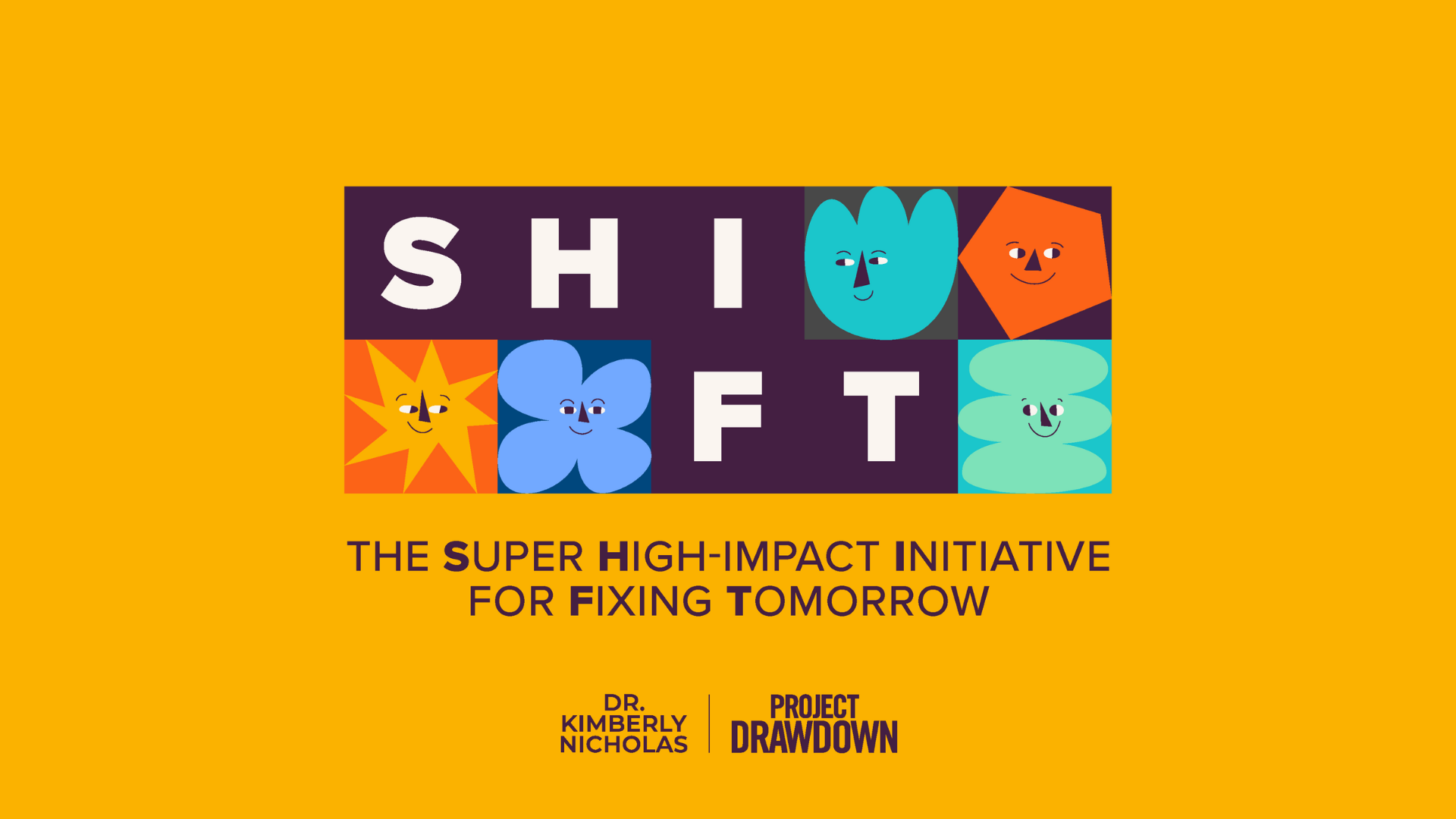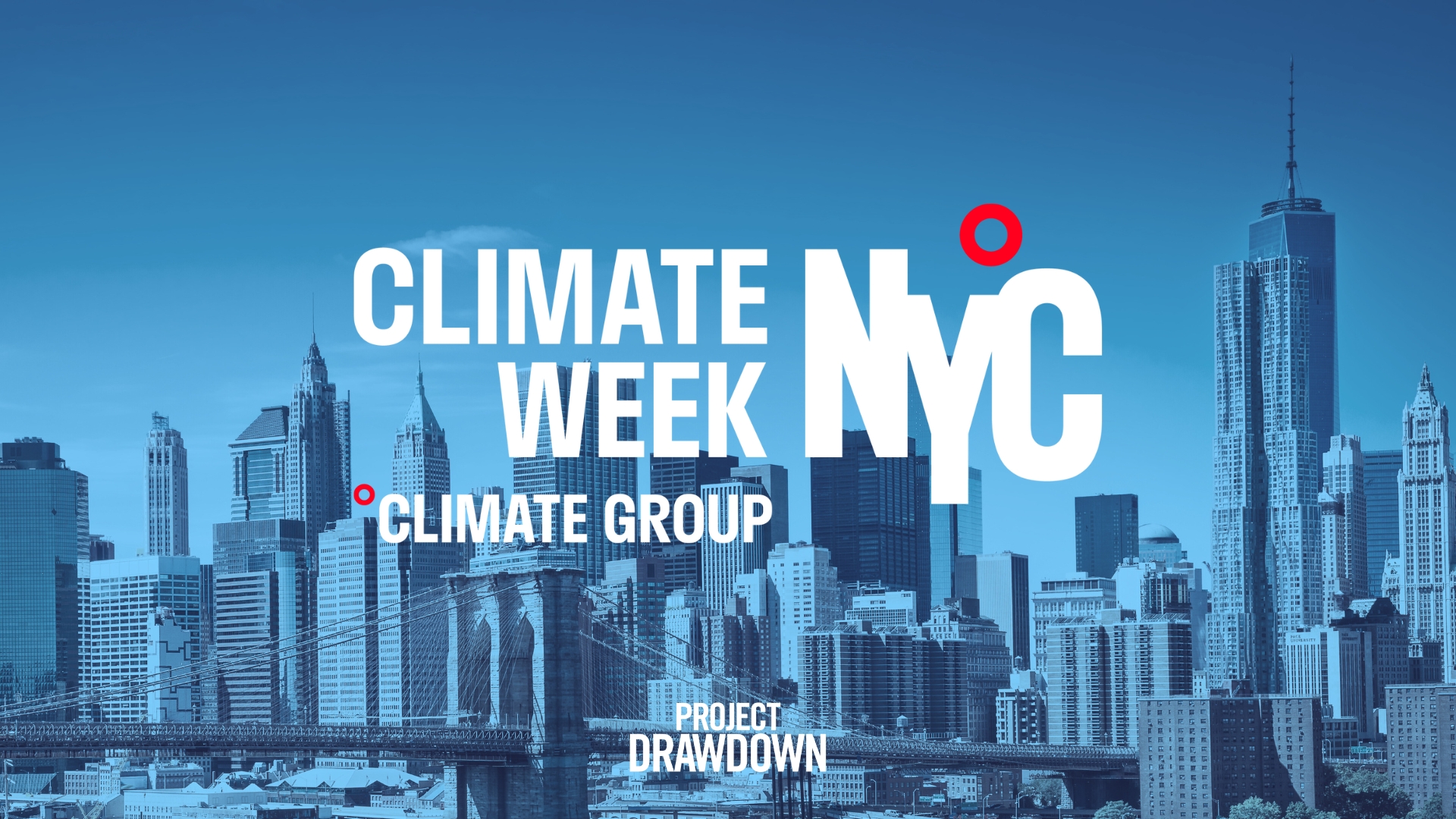Sunday, September 21
Project Dandelion: Women, Climate, and the Nature of Power
4:00–6:00 p.m. ET
The Rockefeller Foundation NYC Headquarters, 420 Fifth Avenue, New York, NY 10018
Project Dandelion will host an intimate circle of climate leaders, artists, and advocates to share provocations and perspectives from women advancing climate solutions and to create space for dialogue that challenges us to move beyond intention into action. Project Drawdown Managing Director Elizabeth Bagley, Ph.D., will join fellow women leaders to explore what becomes possible when ancestral wisdom meets intergenerational imagination and when feminist leadership lights the path forward. Project Dandelion is a coalition of visionary leaders actively imagining and building a more just and climate-safe world.
This session is private and by invitation only. To become a Dandelion and join the collective force of leaders committed to climate justice, please visit Project Dandelion’s website here.
Tuesday, September 23
Introducing Drawdown Explorer: The World’s Most Comprehensive Guide to Climate Solutions
9:25–9:50 a.m. ET
The Javits Center, 445 11th Ave. (Main Stage, Level 3), New York, NY 10001
Join Project Drawdown Executive Director Jonathan Foley, Ph.D., for the world premiere of Drawdown Explorer. This revolutionary, open-access online platform provides detailed, up-to-date intelligence on more than 100 climate solutions that, if scaled, can stop climate change. The Drawdown Explorer is what the climate movement has been missing: an all-encompassing platform using the best available data to provide decision-makers with actionable intelligence on the most effective climate solutions. Built upon trillions of data points and thousands of hours of analysis by scientific experts, the Drawdown Explorer represents a quantum leap in advancing climate solutions, ensuring that every dollar, every resource, and every moment moves us closer to a world without a climate crisis.
Register for The Nest Climate Campus here. Please note, this session will be recorded and shared online following Climate Week.
The Power of Women in Climate Science
11:30 a.m. –1:30 p.m. ET
Treehouse at Doris Duke Center, 444 Madison Avenue (10th floor), New York, NY 10022
Presented by the Doris Duke Foundation and Women & Allies in Climate, this luncheon will provide an engaging, intimate space specifically dedicated to climate science. Project Drawdown Managing Director Elizabeth Bagley, Ph.D., will be among the attendees at the luncheon, which will focus on exchanging groundbreaking ideas and fostering meaningful connections among women scientists and allies who are at the forefront of climate research, policy, and conservation.
Together, attendees will delve into how to better support, empower, and amplify women’s leadership and contributions within climate science. Women globally are leading critical research, developing innovative technologies, and driving policies that address climate challenges, yet often face systemic barriers to accessing resources, visibility, and scalable support.
The luncheon is hosted by:
- Hila Shamon, Deputy Executive Director of Science and Conservation, Duke Farms
- Rebecca Benner, Managing Director for Climate Program, The Nature Conservancy
This session is private and by invitation only. To learn more about the Women & Allies in Climate Network, please visit the website here.
Wednesday, September 24
Roots & Resilience: Seeding Women’s Leadership for a Thriving Planet
8:00–9:30 a.m. ET
The Javits Center, 445 11th Ave, New York, NY 10001
Project Drawdown Managing Director Elizabeth Bagley, Ph.D., will be joining a breakfast and networking event at The Nest Climate Campus featuring women leading innovative climate and nature finance solutions. At this event, attendees will hear from changemakers across philanthropy, policy, grassroots action, and investment – each driving bold, community-rooted change. After a short panel, participants will connect in small roundtables designed to spark meaningful conversation and collaboration.
Unfortunately, space is limited and tickets are no longer available.
Integrating Natural Climate Solutions into Renewable Energy Infrastructure: An Expert Visioning Session
12:00–3:00 PM ET
Register to See Address
In this limited-participation, roundtable discussion facilitated by Diane Pataki, Ph.D., Chief Scientist at the National Wildlife Federation, attendees will create space for frank dialogue and idea exchange, with Chatham House Rules. Participants, including Project Drawdown Managing Director Elizabeth Bagley, Ph.D., will share fresh ideas, form new connections, and build a sense of strategic priorities and opportunities for how we can unite across sectors and disciplines to ensure that progress on clean energy not only continues, but complements conservation and restoration of nature.
Apply here for approval to register for the event.
GIIN's Inaugural Climate Solutions Investing Roundtable: What Will a Below-2° Celsius Economy Require?
2:35-3:20 PM ET
Register to See Address
Project Drawdown Director of Global Strategic Partnerships Amanda Bielawski, Ph.D., will be joining the Global Impact Investing Initiative (GIIN) and more than 10 other experts for a roundtable event on effective climate solutions investing. This half-day event will bring together influential asset owners, investment managers, innovative climate solutions-focused organizations, and leading networks at the intersection of climate and finance. The roundtable will feature expert presentations, insightful panel conversations, sector-specific breakout discussions, and a closing networking reception.
To join the event waitlist, please register here.
Thursday, September 25
Using Technology To Scale A Climate Solution With An Important Dual Mission: Helping To Ending Hunger While Reducing Methane Emissions
9:30–10:15 a.m. ET
The Javits Center, 445 11th Ave. (Main Stage, Level 3), New York, NY 10001
Nearly 40% of the annual food supply in the U.S. goes to waste, while at the same time, over 40 million Americans live in food-insecure households. It makes no sense. In this fireside chat, two visionaries, Project Drawdown Managing Director Elizabeth Bagley, Ph.D., and Joe Robbins, the Chief Product Officer of Food Rescue U.S., will discuss the significant impact keeping nutritious food out of landfills is having on mitigating climate change and feeding the food-insecure. Food recovery is a rewarding climate solution available to almost everyone, and it is a powerful way for employers to get their associates engaged in meaningful climate action. Technology can make it fast, easy, and super efficient.
Register for The Nest Climate Campus here. Please note, this session will be recorded and shared online following Climate Week.
Reimagine Food: Exploring the Intersection of Climate Change and our Global Food System
10:45–11:10 a.m. ET
The Javits Center, 445 11th Ave. (Main Stage, Level 3), New York, NY 10001
When we think of the causes of climate change, often the first thing that comes to mind is the use of fossil fuels for electricity production, transportation, or industry. At the same time, an equally significant, yet far less recognized, contributor to climate change often gets short shrift: the global food system. A whopping 22–33% of all greenhouse gas emissions come from the food, agriculture, and land use sector. To accelerate the adoption of science-based climate solutions in the sector, Project Drawdown has identified seven key areas where actors should focus their efforts. Join Executive Director Jonathan Foley, Ph.D., to learn more and get a sneak peek at a food campaign Project Drawdown will be launching later this year.
Register for The Nest Climate Campus here. Please note, this session will be recorded and shared online following Climate Week.
Communicating Climate Solutions Mini-Summit
11:00 a.m.–2:00 p.m. ET
Register to See Address
The climate crisis is a crisis of imagination. Too often, the narrative is dominated by fear and doom. This half-day brings together sound, story, and design to flip that script - amplifying solution-driven, hope-infused climate storytelling that inspires real change.
By moving through three immersive experiences - listening to powerful narratives, learning how to tell solution-oriented stories, and creating your own climate solution posters - participants leave equipped to shift conversations and spark action in their communities. Featuring Project Drawdown Creative Lead Hannah Jurist-Schoen.
To join the event, please register here.
Culture of Impact: How to Build High-Performing, Planet-Positive Organizations
4:30–5:30 p.m. ET
Hearst Tower, 300 W 57th Street, New York, NY 10019
In today’s business landscape, HR, ESG, and finance leaders and executives are uniquely positioned to shape organizational culture in ways that deliver meaningful impact – not just for the bottom line, but for employees, communities, and the planet.
Join Project Drawdown’s Aiyana Bodi in the LEED Platinum Certified Hearst Tower for an in-depth, solutions-focused conversation on how forward-thinking organizations are operationalizing purpose through policies, practices, and people strategies.
You’ll hear how leaders are using proven frameworks – from B Lab’s updated standards for B Corps to best-in-class HR resources from I Hate it Here – to build high-performing, planet-positive organizations that attract talent, strengthen brand reputation, and drive long-term resilience.
This event will explore:
- How to align purpose, culture, and performance to create lasting impact
- Practical strategies HR leaders can implement to operationalize sustainability and equity goals
- Real-world examples of organizations leveraging frameworks to guide measurable change
- The role of HR as a catalyst for both employee engagement and climate action
Featured Speakers:
- Hebba Youssef, Founder, I Hate it Here
- Kylie Nealis, Senior Program Manager, Climate Justice, B Lab
- Aiyana Bodi, Manager, Drawdown Labs @ Project Drawdown
- Breene Murphy, President, Carbon Collective
- Lizzy Kolar, CEO & Co-founder, Scope Zero
- Special Guest from Hearst
- And more to come!
Be part of a conversation that’s reshaping the future of work. Walk away with practical strategies to align culture with purpose in ways that boost employee performance, strengthen retention, and deliver measurable impact.
To join the event, please register here. Note: A photo ID is required for building entry.
Saturday, September 27
Rewriting Narratives from Brick City to the World: Climate Solutions Rooted in Newark
3:00–4:00 p.m. ET
450 W 31st St 7th floor, New York, NY 10001
Newark, New Jersey, is often framed through a lens of deficit – yet its true story is one of power, resilience, and climate action. In this special session at Marketplace of the Future 2025, we go beyond the narratives of victimhood to uplift Newark’s frontline leadership and community-rooted climate solutions. This is not just a panel, it’s a call to reframe how we see climate justice and who we recognize as leaders. Through powerful storytelling, dynamic performance, and tangible solutions implemented by organizations on the ground, this session, hosted by Project Drawdown Director of Storytelling Matt Scott, explores how cities like Newark are lighting the path forward.
Participants include Drawdown's Neighborhood climate heroes Bilal Walker, Nathaly Agosto Filion, Anthony Diaz, and Christian Rodriguez, as well as Nicole Hewitt-Cabral of the City of Newark.
To join the event, please RSVP here.
We hope this lineup gets you as excited as we are about #ClimateWeekNYC, and we look forward to seeing you in person!



